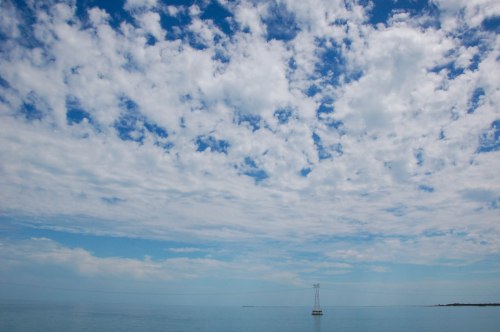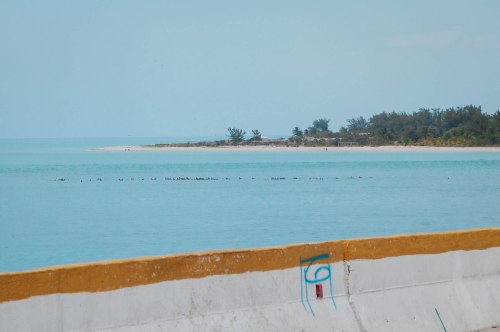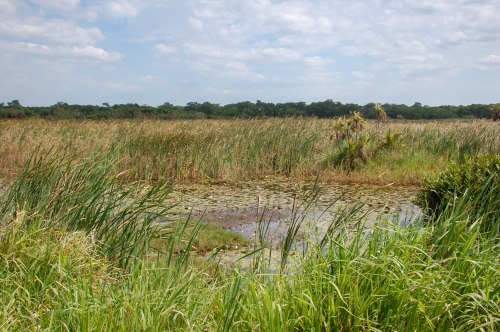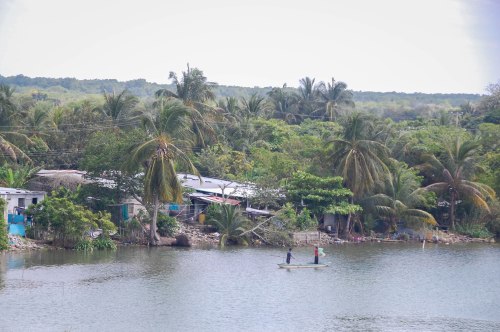Stayed a couple nights in both Ciudad del Carmen and Campeche. Not a whole lot to report on either. Geographically, Ciudad del Carmen is pretty interesting. It is essentially a little island with huge concrete bridges joining it to the mainland on the east and west sides. It used to be a sleepy fishing town up until the 1970’s when Pemex discovered massive oil reserves offshore. Now it serves as home for foreign and Mexican oil workers – many from Texas. High-end hotels and restaurants are plentiful here entwined with the humble shacks and modest old homes of the poor fishermen. Between the 16th and 18th century the island was inhabited by pirates who used to launch raids from here against the Spanish. Curious thing about this place is that it isn’t even mentioned in the Lonely Planet. We stayed at a rundown but character-filled hotel a block off the beach. The hotel looked like it was from a bygone era, the 50’s I’d guess, when the seaside strip was a popular vacation destination. Now most of the hotels along the Playa Norte are crumbling, mosquito-infested relics with inattentive workers and dirty sheets (in our case blood stained). Our hotel had an old school swimming pool and a room transformed into a refuge for parrots and ducks. The parrots would lob abuse at me as I went for my morning swims. The beach, a block away, was packed on the weekends. Not a single gringo anywhere to be seen, just heaps of Mexican families getting shitfaced under tents, palapas, tail-gating. Lots of ATVs and dirt bikes rolling up and down the beach. Garbage everywhere, of course. The funniest part is watching the Mexi’s swim in their clothes. Many of the men even had cowboy hats on, one of which did a backstroke right past us. Probably smart considering the scorching sun this far south. Definitely some of the hottest days I’ve experienced yet. As the expat gringos say, “Campeche is hotter than the hinges of hell.”
While I was waiting for Tanya to show up in town, I found a boisterous vaquero bar a couple doors down from the hotel. It was Sunday afternoon and all of the 50 some tables were full with half-cut vacationing Mexicans sipping micheladas and shooting tequila. There were minstrel mariachi singers in matching shirts going from table to table taking requests. This city really does appear to be for Mexican’s only because there were no other gringos anywhere and I actually felt a bit of a hush as I walked into the festive bar with all eyes falling upon me in stunned surprise. Finding a table was reminiscent of a prison dining room scene from a movie. Once I found a spare seat to slink into, I started to enjoy the jovial scene around me. This was a real traditional, old school Mexican bar. I hadn’t seen any place this lively since the night Sonia and Gerald took me to Hussongs in Ensenada. I started having a blast taking in the music and chatting with the other patrons. I knew I was going to be a bit ‘barach’ by the time Tanya got to town. I did learn a valuable lesson at this restaurant. I ordered an item on the menu called huevas expecting eggs. I realized that the menu said huevas and not huevos, but figured it was either a misprint or a local ambiguity. At no time did it occur to me that I would have a plate of really gross looking sausages filled with fish eggs put in front of me. Apparently, huevas translates to roe in Spanish. The senora sitting in front of the kitchen had a good laugh when I went up to explain my mistake and try to barter for some eggs.
The reason for visiting Ciudad Del Carmen other than it looked real cool on the map, was that we would traverse through the Reserva de les Biosfera Pantanos de Centla which at 300K ha is the largest wetlands reserve in North America. I looked at staying within the reserve but the only lodging I could find online charged 2000 pesos per noche. No thanks. Just driving through on the main road provided a great look at the natural vegetation and birdlife within the reserve. It took nearly two hours to drive through the marshlands and we avoided the assured mosquito onslaught by not staying at a lodge. This region contains one of the most biologically diverse ecosystems in the country with numerous biotopes including dunes, marshes, estuaries, mangroves, and lakes containing both fresh and brackish river. There are also 569 different plant species as well as 39 species of fish, 50 amphibians and reptiles, 60 mammals and 125 of birds. Some of the fauna that call the reserve home are storks, mallard ducks, peregrine falcons, osprey, iguana, crocodiles, manatee, otters, deer, jaguar, ocelots and howler monkeys. As well as protecting the flora and fauna, the reserve is also home to 15,000 Mayan mestizos. They are allowed to stay and live off the land permitted they are not destructive to the ecology. Major threats to the area include: development of the oil industry, lack of security personnel, pollution, deforestation, cattle ranching, illegal fishing and poaching and fires.











